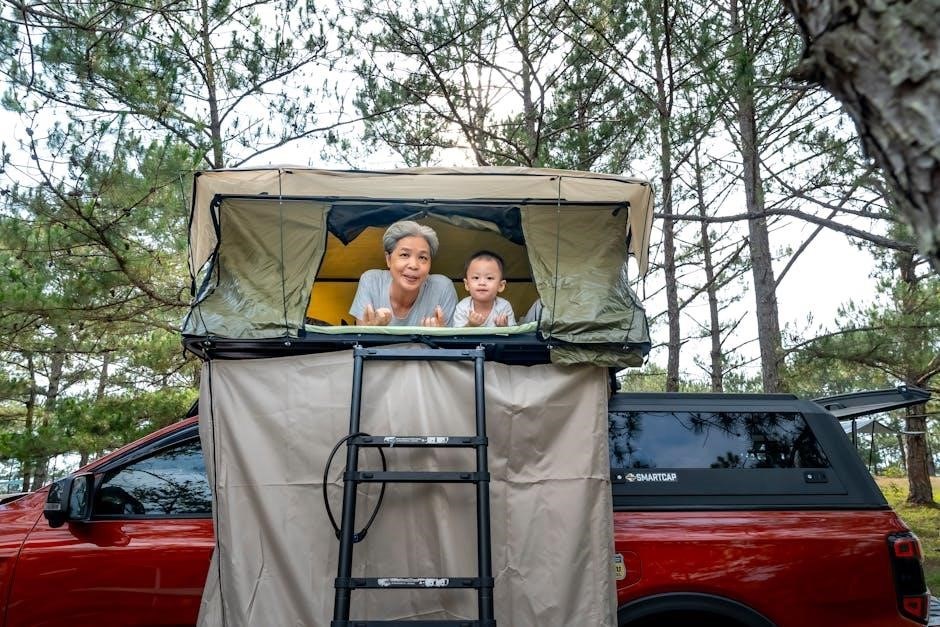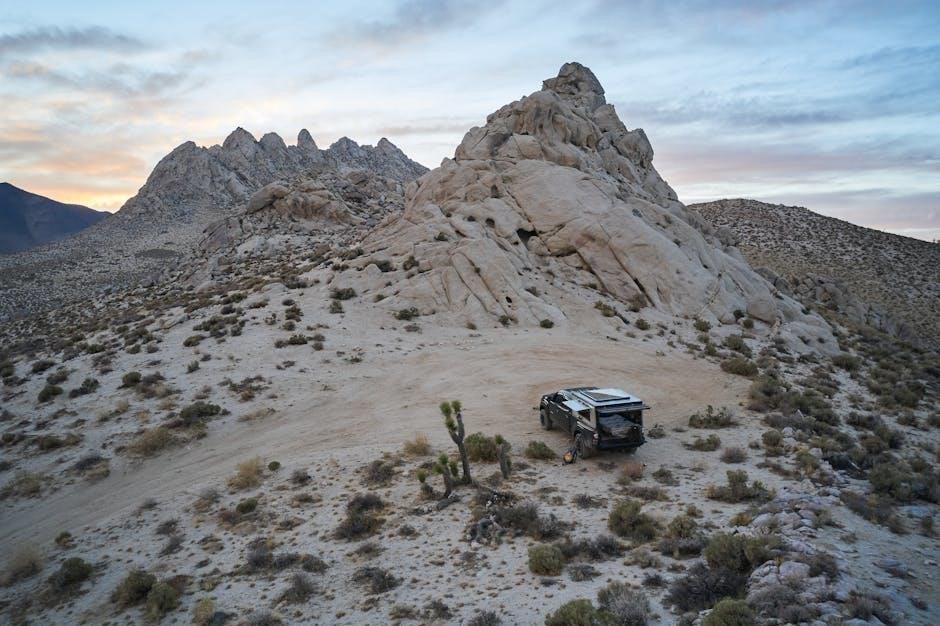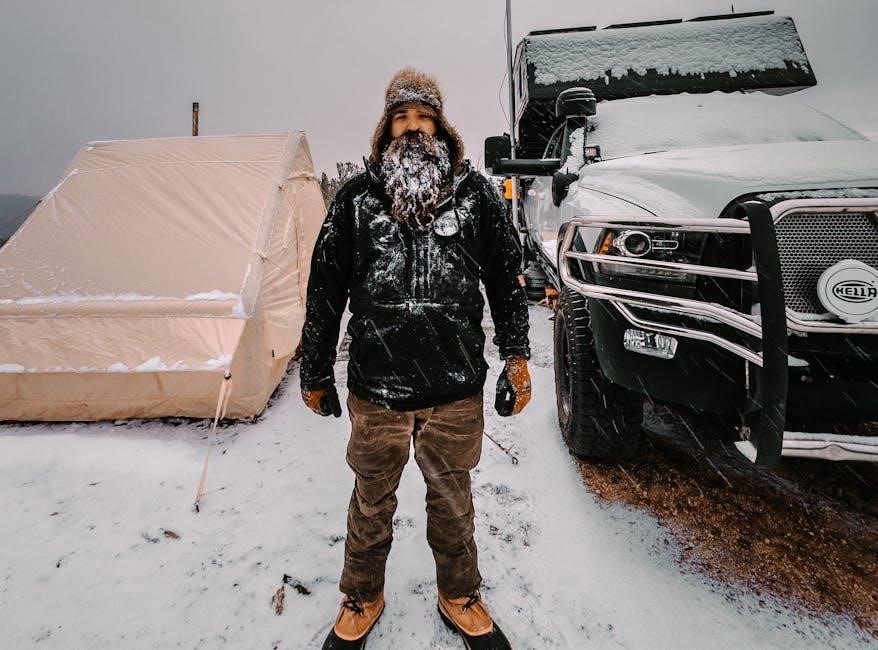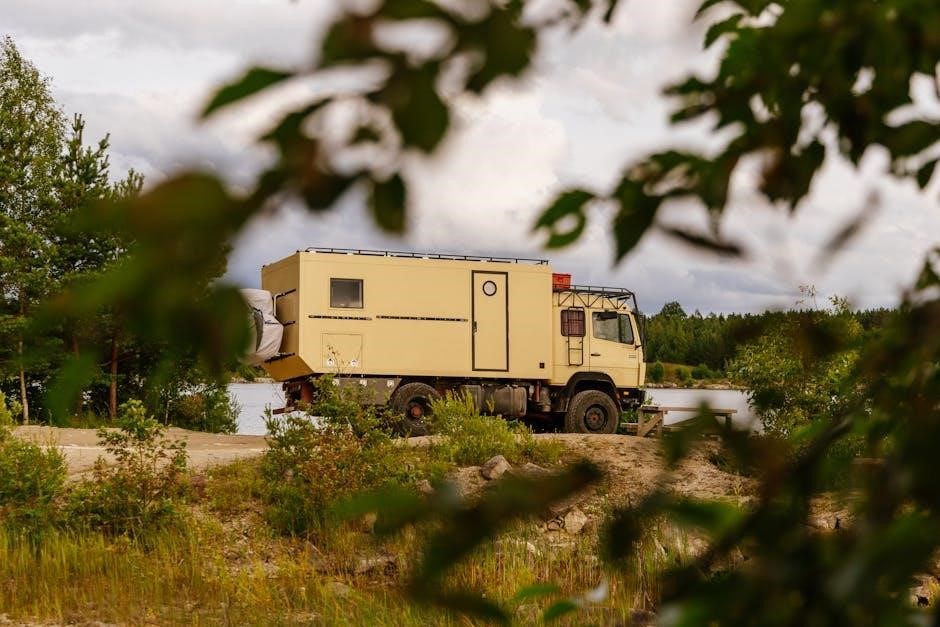Discover comprehensive cabover truck camper plans PDF for a budget-friendly DIY project․ These detailed guides offer step-by-step instructions for building a comfortable, customized camper to suit your truck and lifestyle needs․
Overview of Cabover Truck Camper Plans
Cabover truck camper plans provide detailed instructions for building a custom camper tailored to your truck․ These PDF guides include frame construction, flooring, and insulation, ensuring a durable and comfortable design․ Plans often cater to various budgets and styles, with options to match your truck’s payload capacity; Step-by-step instructions make the process manageable for both DIY enthusiasts and experienced builders․ Customization options allow for personal touches, while pre-designed templates ensure structural integrity and safety․
- Customizable designs to fit your truck bed
- Materials and tools required for construction
- Step-by-step assembly instructions
- Budget-friendly solutions
- Styling options to match your truck
These plans empower you to create a camper that meets your specific needs and preferences․
Importance of Using PDF Plans for DIY Projects
Using PDF plans for your DIY cabover truck camper project ensures clarity and precision․ These documents provide detailed instructions, measurements, and material lists, minimizing errors and saving time․ PDFs are easily accessible on multiple devices, allowing you to reference them anytime, anywhere․ They also offer visual guides and step-by-step instructions, making complex tasks manageable․ By following these plans, you can achieve a professional-quality build, even with limited experience․ This structured approach helps DIYers stay organized and confident throughout the construction process․
- Clear instructions for accuracy
- Accessible on multiple devices
- Visual guides for complex tasks
- Step-by-step construction roadmap
- Professional-quality results

Understanding Cabover Truck Campers
A cabover truck camper is a compact, lightweight camping unit designed to fit over a pickup truck bed․ It offers a space-efficient, aerodynamic solution for camping enthusiasts, providing comfort and convenience while integrating seamlessly with your vehicle․
What Is a Cabover Truck Camper?
A cabover truck camper is a lightweight, compact camping unit designed to fit over a pickup truck bed․ It provides a space-efficient, aerodynamic solution for camping enthusiasts, offering comfort and convenience while integrating seamlessly with your vehicle․ These campers are ideal for those seeking adventure without the need for a separate trailer, allowing for better fuel efficiency and easier maneuverability․ They can be customized to suit various needs, from basic shelter to fully-equipped living spaces, making them a versatile choice for outdoor adventures;
Advantages of Cabover Campers Over Traditional Campers
Cabover truck campers offer superior convenience and efficiency compared to traditional campers․ Their lightweight design improves fuel efficiency and reduces strain on the vehicle․ The compact, aerodynamic structure enhances maneuverability, making them ideal for off-road adventures․ Cabover campers also provide a functional living space while maintaining a lower profile, which simplifies parking and storage․ Additionally, they are cost-effective and customizable, allowing owners to tailor their camper to meet specific needs, making them a versatile choice for outdoor enthusiasts seeking a practical yet comfortable camping solution․
Essential Components of Cabover Truck Camper Plans
Essential components include frame construction, floor unit, plywood requirements, box side uprights, and sandwich structure, ensuring stability and a snug fit on your truck bed․
Frame Construction and Dimensions
Frame construction is the foundation of your cabover camper, requiring durable materials like aluminum or steel for longevity․ Plans typically include detailed dimensions for a secure fit on your truck bed, ensuring proper weight distribution․ Plywood flooring and box side uprights with a sandwich structure enhance stability․ Dimensions are tailored to various truck models, allowing for customization while maintaining structural integrity․ Proper framing ensures safety and a snug fit, making it essential to follow PDF plans carefully for a successful build․
Floor Unit and Plywood Requirements
The floor unit is the foundation of your cabover camper, requiring durable materials for stability․ Plans specify plywood thickness, typically 3/4 inch, for a lightweight yet sturdy base․ Proper sealing and support beams are essential to prevent moisture damage and ensure longevity․ The floor unit must align perfectly with your truck bed for a secure fit․ PDF plans provide detailed specifications and construction tips to ensure a solid base for your camper, emphasizing precise measurements and material quality for safety and durability․
Box Side Uprights and Sandwich Structure
The box side uprights in cabover truck camper plans PDF are constructed using a “sandwich” structure, typically involving plywood and foam insulation between aluminum framing․ This design enhances strength while minimizing weight․ Proper sealing is crucial to prevent moisture damage․ Plans often include detailed dimensions and material specifications for the uprights, ensuring they align with the truck bed for a secure fit․ The sandwich structure also improves insulation, making the camper more comfortable in various weather conditions․ Customization options allow for finishing the exterior to match your truck’s style, ensuring a seamless appearance․

Safety and Legal Considerations

Ensure compliance with US Coast Guard safety standards and local building codes for campers․ Proper electrical, plumbing, and structural integrity are critical for legal and safe operation on the road․
US Coast Guard Safety Standards for Campers
Adhering to US Coast Guard safety standards ensures your camper meets rigorous requirements for flame retardancy, electrical systems, and structural integrity․ These standards are crucial for both marine and road safety, guaranteeing compliance with legal regulations․ Proper wiring, insulation, and material choices are emphasized to prevent hazards․ By following these guidelines, you can build a camper that is not only safe but also durable and reliable for long-term use, aligning with the detailed instructions provided in cabover truck camper plans․
Ensuring Compliance with Local Building Codes
When building a cabover truck camper, it’s essential to comply with local building codes to ensure safety and avoid legal issues․ Research and verify regulations regarding materials, electrical systems, and structural requirements․ PDF plans often include guidelines to help meet these standards․ Always consult local authorities before starting your project to confirm compliance․ Regular inspections may be required to maintain adherence to building codes, ensuring your camper is both safe and legally approved for use․
Design and Planning
Customize your cabover truck camper to match your truck’s specifications, budget, and personal style․ Plan carefully to ensure functionality, comfort, and durability for your DIY project․
Customizing Your Camper to Match Your Truck

Customizing your cabover camper to match your truck ensures a seamless fit and optimal functionality․ Use PDF plans to specify dimensions, frame construction, and material choices that align with your truck’s make and model․ Consider the truck’s bed size, weight capacity, and cab style when designing the camper․ This customization allows for a secure installation and enhances the overall appearance, making your camper a perfect extension of your vehicle․
Considering Budget, Style, and Payload Needs
When planning your cabover truck camper, budget, style, and payload capacity are crucial factors․ PDF plans can help you estimate costs for materials and tools, ensuring your project stays affordable․ Choose a design that matches your truck’s aesthetics and your personal style․ Consider the weight limits to avoid exceeding your vehicle’s payload capacity, ensuring safe and efficient towing․ Balancing these elements guarantees a functional and stylish camper tailored to your needs and preferences․
Building the Frame
Construct a sturdy frame using plywood and aluminum, ensuring a durable base․ Follow PDF plans for precise dimensions and materials to achieve a solid structure for your camper․
Materials and Tools Required for Framing
Gather essential materials like plywood, aluminum framing, and steel brackets for durability․ Tools include drills, saws, and wrenches for precise cuts and secure assembly․ Ensure you have fasteners, sealants, and insulation materials ready to complete the sturdy frame structure effectively․
Step-by-Step Instructions for Frame Assembly
Explore detailed cabover truck camper plans PDF for a cost-effective and customizable DIY project․ These guides provide comprehensive instructions for crafting a comfortable camper tailored to your truck and personal preferences, ensuring a successful and enjoyable build experience․
Insulation and Interior
Enhance your cabover camper with rigid foam insulation and alternative materials like canvas or fiberglass․ Install windows and lighting for a cozy, well-lit interior space․
Using Rigid Foam Insulation and Alternative Materials
Rigid foam insulation is a popular choice for cabover campers, offering excellent thermal performance and lightweight construction․ Alternative materials like canvas or fiberglass can be used for walls and roofs, providing durability and flexibility․ Some builders opt for innovative methods, such as wrapping foam insulation in canvas and coating it with Tightbond II, creating a durable, weather-resistant finish․ These materials not only reduce weight but also simplify the building process, making them ideal for DIY projects․ Proper application ensures a comfortable and energy-efficient living space․
Installing Windows and Lighting Systems
Properly installing windows and lighting systems is crucial for functionality and comfort․ Use high-quality, weather-tight windows to ensure natural light and ventilation․ Lighting systems, such as LED strips or recessed lights, can be powered by a 12-volt electrical setup․ USB ports and receptacles should be strategically placed for convenience․ Ensure all wiring is safely routed and meets electrical standards․ This setup enhances visibility, safety, and energy efficiency, creating a cozy and functional living space within your cabover camper․
Electrical and Plumbing Systems
Essential for modern camping, electrical and plumbing systems provide power and water management; Wiring and 12-volt setups support lighting and appliances, while water tanks and pumps ensure self-sufficiency and efficiency․
Wiring and 12-Volt System Setup
Setting up a reliable 12-volt electrical system is crucial for powering lights, USB ports, and appliances․ Use marine-grade wiring and components to ensure durability and safety․ Connect the system to your truck’s battery for seamless energy supply․ Proper insulation and grounding are essential to prevent electrical issues․ Many builders integrate solar panels for off-grid capability․ Detailed PDF plans provide step-by-step guidance for wiring setups, ensuring functionality and safety․ Customize the system to meet your specific needs, whether for lighting, charging devices, or powering small appliances․
Plumbing Options for Water and Waste Management
Effective plumbing is essential for water and waste management in your cabover camper․ Install a water tank with a pump for freshwater supply and a waste tank for greywater․ Consider compact, portable toilet solutions or external shower systems․ Use marine-grade components for durability․ Detailed PDF plans guide you through installing valves, pipes, and fittings․ Opt for simple, self-contained systems to minimize complexity․ Proper venting and insulation ensure reliable operation․ DIY guides offer tips for customizing your setup to suit your camping needs and preferences․

Exterior Finishing
Exterior finishing enhances durability and aesthetics․ Opt for painting or natural finishes to match your truck․ Use durable coatings like rubberized paint for weather resistance․ Detailed PDF plans guide you through optional designs, ensuring a seamless look with your vehicle․ Lightweight materials and streamlined designs improve fuel efficiency and stability․ Customize colors and styles to personalize your camper․ Proper finishing protects against environmental elements, ensuring long-term longevity․ Follow step-by-step instructions for a professional-grade exterior that complements your truck seamlessly․
Painting and Coating Options for Durability
Protect your cabover camper with durable painting and coating options․ Use rubberized roofing paint or liquid rubber systems for weather resistance․ Apply high-quality exterior paints or clear coats to maintain a polished look․ Natural finishes offer a sleek, low-maintenance option․ Consider spray-painting to match your truck’s color for a cohesive appearance․ Proper preparation and application ensure longevity․ PDF plans provide detailed guidance for achieving professional-grade finishes that withstand harsh outdoor conditions while enhancing your camper’s visual appeal and structural integrity․
Optional Exterior Designs to Match Your Truck
Elevate your cabover camper’s appearance with optional exterior designs that complement your truck․ Consider matching the camper’s color scheme or adding custom decals for a personalized look․ Trim and molding can be added to create a seamless aesthetic․ For a rugged style, incorporate textured finishes or metallic accents․ PDF plans often include ideas for exterior customization, ensuring your camper looks like a professional-grade extension of your vehicle while maintaining functionality and durability on the road․

Weight and Payload Management
Managing weight is crucial for safe towing․ Use lightweight materials and optimize design to reduce camper weight, ensuring your truck stays within payload limits for stability․
Understanding Weight Limits for Safe Towing
Weight limits are critical for safe towing․ Ensure your truck’s payload capacity exceeds the camper’s weight, including all gear and fluids․ Exceeding limits can compromise safety and damage your vehicle․ Always consult your truck’s manufacturer specifications and calculate the camper’s dry weight plus additions like water, propane, and batteries․ Proper distribution of weight is equally important to maintain stability and control while towing․ Plan carefully to avoid overloading and ensure a secure, enjoyable journey․
Strategies to Reduce Camper Weight
To keep your cabover camper lightweight, use rigid foam insulation and minimalistic designs․ Opt for lightweight materials like aluminum framing or PVC foam core․ Avoid heavy components and focus on essential features․ Ensure the camper’s weight distribution aligns with your truck’s payload capacity for safe towing․ Regularly monitor and adjust the camper’s load to maintain optimal weight levels, ensuring durability and performance without compromising safety or comfort․
Maintenance and Repairs
Regular inspections of insulation, electrical systems, and structural integrity are crucial․ Addressing minor repairs promptly prevents major issues, ensuring your camper remains safe and functional for years․
Regular Maintenance Tips for Longevity
Regular inspections and maintenance are vital for extending the life of your cabover truck camper․ Check for leaks in the roof and windows, and ensure all seals are tight․ Inspect electrical and plumbing systems for damage or wear․ Protect the exterior with a durable paint or coating to prevent rust and weather damage․ Additionally, inspect the structural frame for any signs of weakening or damage․ Addressing these issues promptly will help prevent costly repairs and ensure your camper remains safe and functional for years to come․
Common Repair Issues and Solutions
Common repair issues in cabover truck campers include leaks in the roof and windows, electrical system malfunctions, and structural frame weakening․ For leaks, resealing with waterproof materials or replacing damaged seals is effective․ Electrical issues often involve faulty wiring or blown fuses, which can be repaired by inspecting connections and replacing components․ Structural damage may require reinforcing the frame with additional supports or brackets․ Addressing these problems early ensures your camper remains durable and functional, preventing more extensive and costly repairs down the line․

Budgeting and Cost Estimation
Estimate materials and tools for your cabover camper project․ Compare DIY costs to pre-built options, ensuring your build stays within budget while meeting style and payload needs․
Estimating Costs for Materials and Tools
Estimate costs by listing materials like plywood, insulation, and framing supplies, with tools such as saws and drills․ Budget at least $1,000 for basic materials and $500 for tools․ Higher-end builds can range up to $6,000․ Compare DIY costs to pre-built campers, which start around $10,000․ Plan for optional upgrades like electrical systems or exterior finishes․ Detailed PDF plans often include cost breakdowns, helping you stay within budget while customizing your camper to meet payload and style needs․
Comparing DIY Costs to Pre-Built Campers
DIY cabover truck campers can save significant costs, with materials and tools typically ranging from $1,000 to $6,000․ Pre-built campers often start at $10,000 or more, making DIY a budget-friendly option․ While pre-built models offer convenience, DIY allows customization and potential long-term savings․ Detailed PDF plans provide cost breakdowns, helping you compare expenses and decide the best route for your budget and needs․

Case Studies and Examples
Explore inspiring examples of successful DIY cabover camper builds, including a cost-effective $6,000 project and a lightweight, naturally finished camper for a sleek, functional design․
Successful DIY Cabover Truck Camper Builds
A $6,000 DIY cabover camper showcases creativity and practicality, featuring a natural finish and weighing just 260 pounds․ Built with rigid foam insulation, canvas, and Tightbond II, it includes a 12-volt system and USB ports․ The builder shared lessons learned, emphasizing material choices and design simplicity․ This project demonstrates how affordable and customizable cabover campers can be, inspiring others to embark on their own builds with confidence and creativity․
Lessons Learned from Experienced Builders
Experienced builders emphasize the importance of material selection and weight management․ Using affordable materials like XPS foam or PVC foam core with fiberglass can save costs without compromising durability․ Simplifying designs and avoiding unnecessary complexity helps prevent common issues․ Builders also highlight the value of detailed planning to ensure proper fit and functionality․ Lessons include considering removable features for versatility and prioritizing insulation for comfort․ These insights provide valuable guidance for those embarking on their own cabover truck camper projects․
With detailed cabover truck camper plans PDF, you can confidently embark on your DIY project․ These guides provide everything needed to create a functional, stylish camper, ensuring success and satisfaction for your adventures․
Final Tips for a Successful DIY Project
For a thriving DIY cabover truck camper build, prioritize precise measurements and adhere to your plans․ Opt for durable materials like rigid foam insulation and ensure proper wiring for the 12-volt system․ Plan your budget carefully, balancing style and functionality while considering payload limits․ Regularly inspect your work and test systems before use․ Stay organized, and don’t hesitate to seek advice from online forums or experienced builders․ With patience and dedication, your cabover camper will become a cozy, reliable adventure companion․
Encouragement to Start Your Cabover Camper Build
Embark on your cabover truck camper journey with confidence! Building your own camper offers a rewarding experience, allowing you to customize every detail to your preferences․ With detailed PDF plans and online resources, you’ll have clear guidance to bring your vision to life․ Whether you’re aiming for a budget-friendly solution or a luxurious upgrade, the freedom to create something tailored to your needs is empowering․ Don’t hesitate—start your project today and transform your truck into a cozy home on wheels!